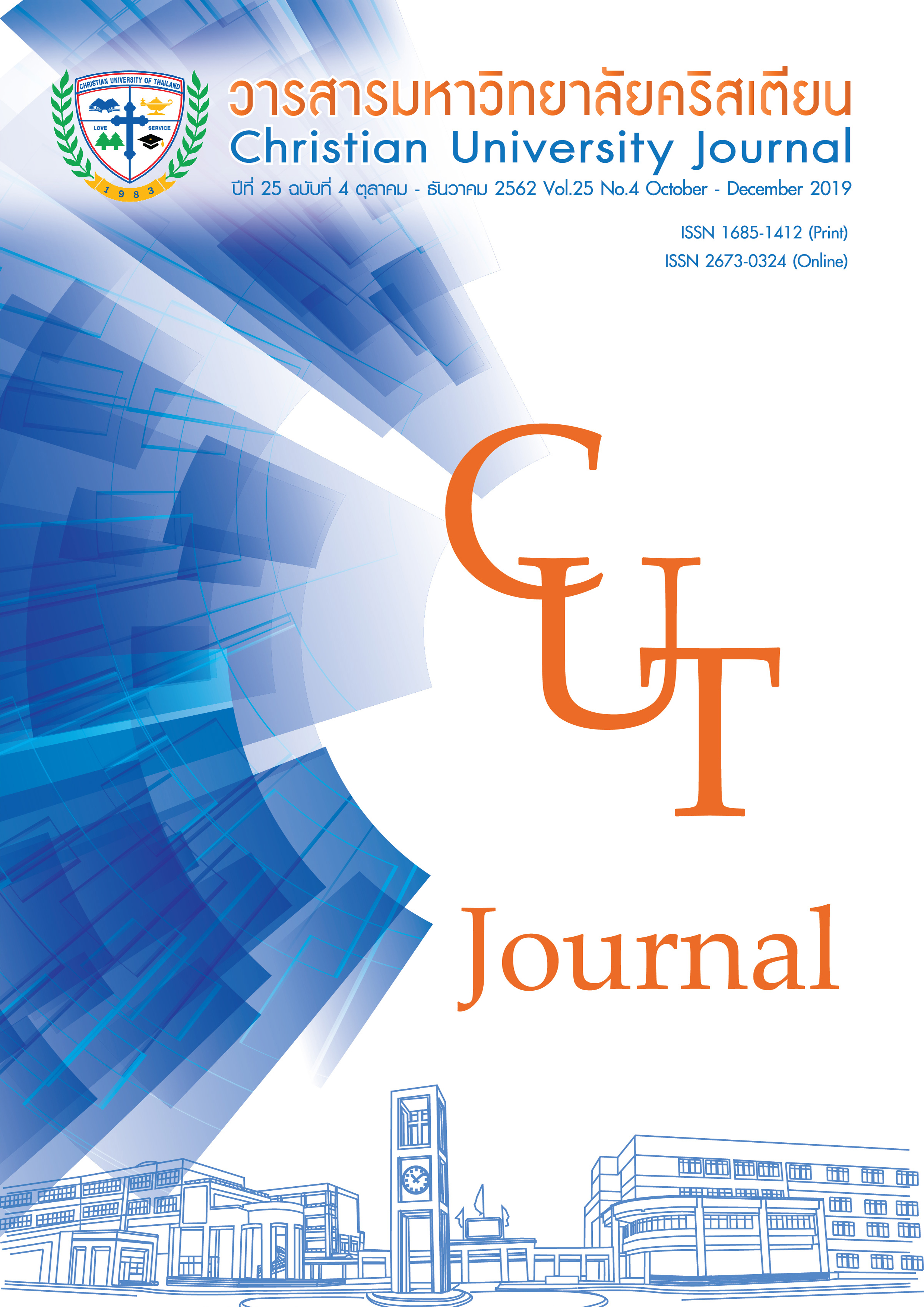การเปรียบเทียบการเปลี่ยนแปลงท่าทางและความรู้สึกไม่สบายของร่างกาย ขณะนั่งเรียนด้วยโต๊ะและเก้าอี้ 2 รูปแบบ
คำสำคัญ:
ความรู้สึกไม่สบายของร่างกาย, การเปลี่ยนแปลงท่าทาง,, ท่าทางการนั่งในห้องเรียนบทคัดย่อ
โต๊ะและเก้าอี้เป็นส่วนสำคัญในการนั่งเรียน การนั่งโต๊ะและเก้าอี้ที่ไม่เหมาะสมเป็นเวลานานจะนำไปสู่โรคทางระบบกระดูกและกล้ามเนื้อ เพื่อเปรียบเทียบการเปลี่ยนแปลงท่าทางและความรู้สึกไม่สบายของร่างกายในการนั่งเรียนด้วยโต๊ะและเก้าอี้ 2 รูปแบบ ประกอบด้วย 1) แบบไม่มีพนักพิงที่รองรับบริเวณหลังส่วนล่าง 2) แบบมีพนักพิงที่รองรับบริเวณหลังส่วนล่าง โดยนักศึกษาหญิงจำนวน 19 คน ถูกบันทึกท่าทางขณะนั่งเรียนเป็นระยะเวลา 60 นาที ในแต่ละรูปแบบ โดยก่อนและหลังทำการทดสอบจะถูกประเมินด้วยแบบประเมินความรู้สึกไม่สบายของร่างกาย และการเปลี่ยนแปลงของท่าทางจะถูกประเมินด้วยแบบประเมิน RULA นาทีที่ 10 และ 50 ผลการศึกษาพบว่าไม่มีความแตกต่างกันอย่างมีนัยสำคัญทางสถิติของลักษณะท่าทางขณะนั่งเรียนด้วยโต๊ะและเก้าอี้ 2 รูปแบบ มีความแตกต่างกันอย่างมีนัยสำคัญทางสถิติของการเปลี่ยนแปลงท่าทางนั่งเรียนด้วยโต๊ะและเก้าอี้รูปแบบที่ 1 และมีความแตกต่างกันอย่างมีนัยสำคัญทางสถิติของความรู้สึกไม่สบายของร่างกายก่อนและหลังการนั่งเรียนด้วยโต๊ะและเก้าอี้ 2 รูปแบบ
เอกสารอ้างอิง
มัณฑนา วัชรินทร์รันต์ และ ธนัชพร คงไทย. (2561). เทคโนโลยีที่ใช้รักษาออฟฟิศซินโดรม. วารสาร มหาวิทยาลัยคริสเตียน, 24(3), 479-491.
รุ่งทิพย์ เฉลิมแสน, รุ้งทิพย์ พันธุเมธากุล, วนิดา ดรปัญหา, ทกลม กมลรัตน์, อุไรวรรณ ชัชวาลย์, รวิพร พิทักษ์, ปรัชญา กาละดี. (2016). ผลของโปรแกรมการออกกำลังกายเพื่อเสริมสร้างความมั่นคงของลำตัวในผู้ที่มีอาการปวดหลังส่วนล่างแบบไม่จำเพาะเจาะจงที่อยู่ในระยะกึ่งเฉียบพลัน: การศึกษานำร่อง. วารสารพยาบาลและสุขภาพ, 39(1), 48-60.
Castellucci H, Arezes P & Molenbroek J. (2015). Analysis of the most relevant anthropometric dimensions for school furniture selection based on a study with students from one Chilean region. Applied ergonomics, 46, 201-211.
Claus AP, Hides JA, Moseley GL & Hodges PW. (2016). Thoracic and lumbar posture behaviour in sitting tasks and standing: Progressing the biomechanics from observations to measurements. Applied ergonomics, 53, 161-168.
Daneshmandi H, Isanezhad A & Hematinezhad M. (2008). The effects of classroom furniture on back, neck, lumbar and leg fatigue in student. Journal of Movement Sciences and Sports, 1, 37-44.
Finando D & Finando S. (2005). Trigger Point Therapy for Myofascial Pain: The Practice of Informed Touch. Simon and Schuster.
Ghosh T, Das B, & Gangopadhyay S. (2010). Work-related Musculoskeletal Disorder: An Occupational Disorder of the Goldsmiths in India. Indian journal of community medicine: official publication of Indian Association of Preventive & Social Medicine, 35(2), 321-325.
Grimes P & Legg S. (2004). Musculoskeletal disorders (MSD) in school students as a risk factor for adult MSD: a review of the multiple factors affecting posture, comfort and health in classroom environments. Journal of the Human-Environment System, 7(1), 1-9.
Karwowski W, & Marras WS. (2003). Occupational Ergonomics: Engineering and Administrative Controls: Taylor & Francis.
Liebenson, C. (2007). Rehabilitation of the Spine: A Practitioner's Manual: Lippincott Williams & Wilkins, 217.
Macedo AC, Morais AV, Martins HF, Martins JC, Pais SM & Mayan OS. (2015). Match between classroom dimensions and students’ anthropometry: re-equipment according to european educational furniture standard. Human Factors, 57(1), 48-60.
Marras WS & Karwowski W. (2006). Fundamentals and Assessment Tools for Occupational Ergonomics: CRC Press.
McAtamney L, and Nigel CE. (1993). RULA: a survey method for the investigation of work-related upper limb disorders. Applied Ergonomics, 24(2), 91-99.
Navaid S, Farooqui SI, Omar Z. (2012). The association of sitting posture and cervicogenic pain among the students of Physical Therapy. Pakistan Journal of Rehabilitation, 1(1), 44-9.
Ozturk N, & Esin MN. (2011). Investigation of musculoskeletal symptoms and ergonomic risk factors among female sewing machine operators in Turkey. International Journal of Industrial Ergonomics, 41(6), 585-591.
Panagiotopoulou G, Christoulas K, Papanckolaou A & Mandroukas K. (2004). Classroom furniture dimensions and anthropometric measures in primary school. Applied ergonomics, 35(2), 121-128.
Quemelo PRV, Gasparato FDS & Vieira ER. (2015). Prevalence, risks and severity of musculoskeletal disorder symptoms among administrative employees of a Brazilian company. WORK, 52(3), 533-540.
Salvendy G. (2012). Handbook of Human Factors and Ergonomics. United Kingdom : John Wiley & Sons.
Sharan D & Ajeesh P. (2012). Correlation of ergonomic risk factors with RULA in IT professionals from India. WORK, 41(Supplement 1), 512-515.
Tirloni AS, Dosreis DC, Soares M & Moro ARP. (2014). Influence of the school furniture design on the body posture of college students. Advances in Ergonomics In Design, Usability & Special Populations Part II, 364-370.
Zemp R, Taylor WR & Lorenzetti S. (2015). Are pressure measurements effective in the assessment of office chair comfort/discomfort? A review. Applied ergonomics, 48, 273-282.



